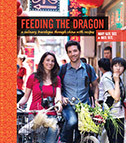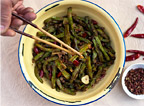crossing the bridge noodles (guoqiao mixian)

Several people asked me last week how Nate and I were able to talk our way back into restaurant kitchens in China. In fact, this is one of the most common questions we get asked right after how do you as siblings work together and not kill each other? (For this, all I can say is stay tuned, that may very well happen one day. There was a certain time this weekend when Nate erased the contents of my camera without asking that brought about a close call.)
I vividly remember the first place in China that we asked if we could venture back into the kitchen to take pictures and observe the chef. It was a hole-in-the-wall bake shop in the city of Nanjing where the cook was decorating Western-style cakes. We were so nervous. All I could imagine was what would happen if we walked into a NYC restaurant and asked to observe in the kitchen! With a camera! We would wait as Gordon Ramsay or some other formidable chef with furrowed brow would stomp out of the back and undoubtedly, personally throw us out the door.
Nate nervously told the bake shop's store clerk that we were there in Nanjing to collect recipes for Westerners and would she be so kind as to show us into the kitchen. Fortuitously, kindly, confusedly she did. We were so thrilled at the opportunity that we literally took 90 pictures in the 15 minutes we were there. The unfortunate part of this adventure was that the camera was set to the wrong shutter speed and every last picture was blurry (see the one picture that worked out here). But it didn't matter; we were hooked. We got very good at smiling and explaining our odd mission. Of course, more times than not, we didn't get our wish, but I will always be grateful to the many generous and mysterious cooks all across China who, wanting to share their delicious and under-appreciated cuisine with the world, offered lessons to this modest, aspiring cook and perpetually hungry traveler.
This brings me to my dinner last night, Crossing the Bridge Noodles, a dish from Yunnan Province and the local restaurant cook without whom I never would have thought to add cilantro. Yunnan residents are very proud of their food and Crossing the Bridge Noodles is famous all over China. The story behind these noodles goes: there once was a scholar who, studying for an important exam, isolated himself in a cottage away from distractions. Every night his wife crossed a long bamboo bridge to bring him noodles, but they were often cold by the time she reached his table. Being somewhat smarter than her scholar husband, she devised a plan. She poured a layer of chicken fat on top of the broth to insulate the noodles from the cold air and keep them hot until she arrived at her husband's cottage. And yes, the scholar passed his exam.
When we were in Kunming, the capital of Yunnan, I couldn't get enough of this pleasantly salty, healthy, fresh and light noodle soup. The soup's ingredients are brought to the table raw-- fresh and overflowing: squid, shrimp, chicken, spinach, prosciutto ham, chinese black mushrooms. Add to your liking and they cook right in your bowl! It's delightful and always leaves me feeling like I've eaten all my omega 3 vitamins and vegetables for the day. Of course, the original recipe calls for a thick layer of chicken fat on top of the broth, but we've excluded that from our recipe. If you're not traveling far, it doesn't affect the flavor much and let's face it, who of us wouldn't do well to forego "chicken fat" in our meal when it's not totally necessary?
-mary kate

UPDATE: A reader made a comment asking if he can use frozen calamari rings instead of fresh squid bodies and we say yes! I found some beautiful fresh squid at the seafood market over the weekend but I have used frozen calamari rings before and they also work and take less prep time.
Crossing the Bridge Noodles
(Makes 4 bowls)
8 dried Chinese black mushrooms
8 oz round rice noodles
1/4 lb squid bodies
1/4 lb medium size shrimp, headless and shelled
1 small chicken breast
1 bunch spinach, leaves only
1/4 lb prosciutto ham, thinly sliced
6 cups chicken stock
3 tablespoons vegetable oil
2 tablespoons Shaoxing rice wine
3 green onions, chopped
1 teaspoon ginger, finely chopped
1/4 teaspoon salt, or to taste
1 handful fresh cilantro leaves, rinsed
Soak the mushrooms in warm water for 20 minutes, drain, and set aside. Prepare the rice noodles according to their package, drain, and set aside. Bring a pot of water to a rolling boil for blanching the ingredients. Clean and prepare the squid and slice into small ringlets. Blanch the squid in the boiling water for 1 minute then remove with a strainer. Slice the shrimp length-wise and blanch for 1 minute, then remove with a strainer. Slice the chicken paper-thin and blanch for 1 minute, then remove with a strainer. Blanch the spinach for 1 minute, drain, and set aside.
In a large covered pot, bring the chicken stock, vegetable oil, Shaoxing rice wine, green onions, ginger, and salt to a rolling boil for 1 minute. Submerge four large ceramic soup bowls in the sink under hot tap water until they are very warm. Place 1/4 of the noodles in each bowl. On top of the noodles, place 1/4 of the squid, shrimp, chicken, spinach, and prosciutto. Pour the boiling broth into the bowls and let them sit for 2 minutes. Top each bowl with a little cilantro and serve.


 health,
health,  recipes,
recipes,  seafood,
seafood,  soups,
soups,  vegetables
vegetables 









